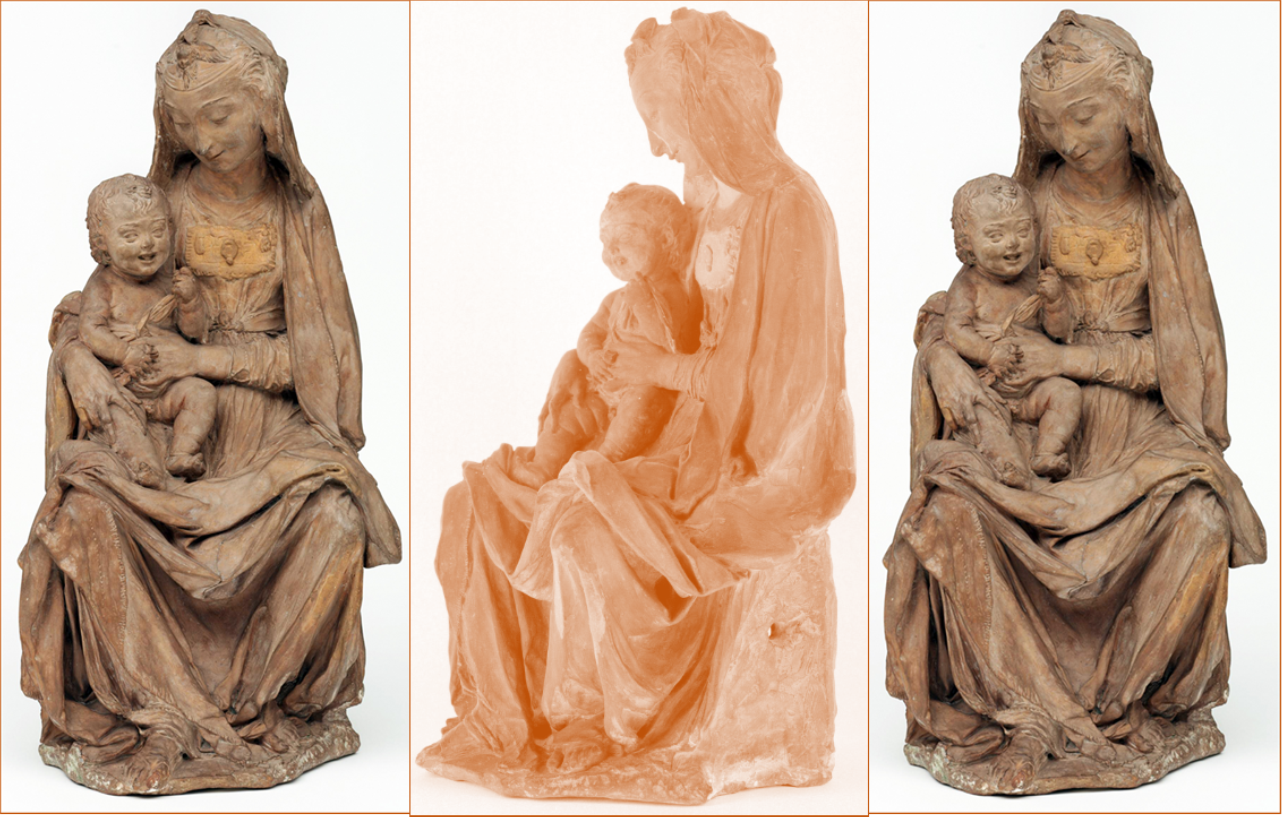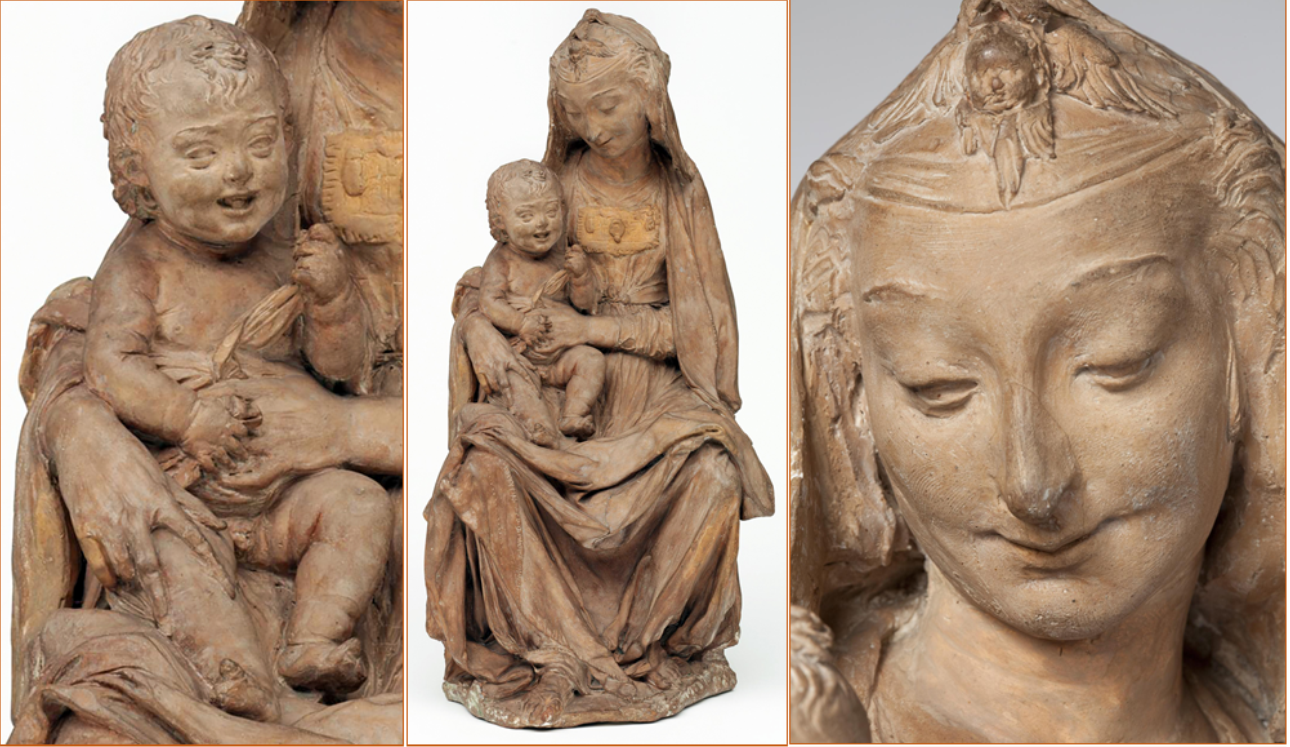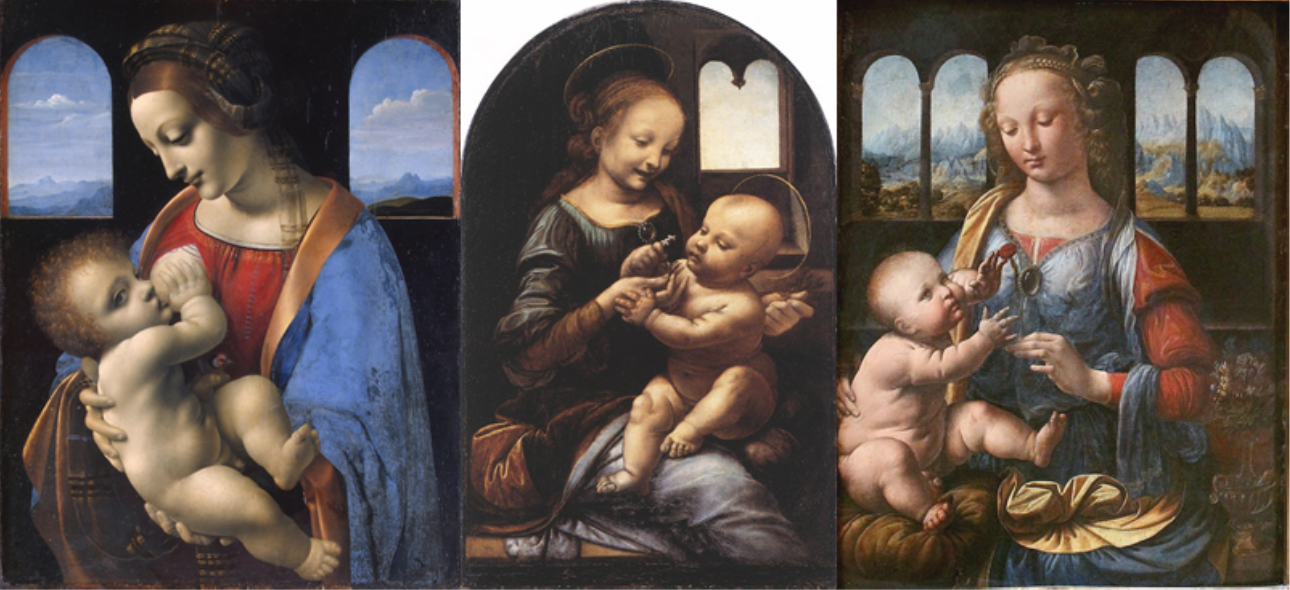Italian scholars unveil 'Virgin and Laughing Child'
as Leonardo da Vinci’s only surviving sculpture

 Experts say crucial details prove
Experts say crucial details prove
the sculpture is Leonardo's work
by Jonathan Jones

March 9, 2019
The curators of an exhibition in Florence have this week unveiled what they claim is the only surviving sculpture by Leonardo da Vinci.
It’s always been part of Leonardo’s legend that he made sculptures, including a giant horse, but not a single extant three-dimensional work by him had been identified.
'The Virgin with the Laughing Child' is the miraculous exception, according to the curators of the exhibition 'Verrocchio: Master of Leonardo', at Palazzo Strozzi, where it has just gone on display. It has an unambiguous label: Leonardo da Vinci. He is said to have created it around 1472, when he was 19 or 20 and a pupil of the Florentine artist Andrea del Verrocchio.
The UK has a special interest in the find, which has belonged to the Victoria & AlbertMMuseum since 1858 but had long been credited to another artist, Antonio Rossellino. That is because scholars had been bamboozled by the posthumous authority of the late art historian and British Museum director John Pope-Hennessy, according to Francesco Caglioti, the Italian academic who is leading the new attribution.
Caglioti, who teaches at Naples University, is well known among Renaissance experts for his unrivalled knowledge of 15th-century sculpture: an art history prodigy who made a catalogue of the Louvre when he was eight.
Victorians had no difficulty seeing the Leonardo-esque look of the V&A treasure, he said. The Virgin Mary looks down at the ChristCchild on her lap with what may be the prototype of all the enigmatic smiles in Leonardo’s art, the most famous of which is the Mona Lisa’s.
Experts say details such as the drapery and Christ’s smile show it to be Leonardo Da Vinci’s work.
Pope-Hennessy, a hugely powerful 20th-century expert, pronounced that the sculpture was by Rossellino, and that was that. But he had no real evidence for his ruling, claimed Caglioti, and heavily promoted Rossellino, to whom he attributed works “at his whim”.
Awestruck journalists at the press viewing of 'Verrocchio: Master of Leonardo gathered around the 50cm-tall red clay (terra cotta) sculpture in its protective vitrine while Caglioti expounded why he thought it was 100% Leonardo.
Revered Leonardo scholar Carmen C Bambach, from the Metropolitan Museum in New York, was also there to support the claim.
They focus on two crucial details. First, the voluminous, complicated draperies that flow over the Madonna’s legs are similar to drawings of draperies Leonardo was making at the time. These drawings, exhibited in the Strozzi show, are almost obsessive studies of abstract folds and shadowy recesses. Caglioti and Bambach believe they can see the same qualities in the sculpture.
Second, there’s the face of the baby Christ and his realistic, well-observed pose. He looks alive. That same attention to young children’s actual behaviour can be seen in Leonardo’s drawings. Yet portraying a laughing Christ in the 15th century was not only radical, but practically blasphemous.
In a passage in Leonardo’s notebooks, he remembers getting into trouble when younger for portraying the infant Christ. Could this be the work that got him in hot water?
The V&A is cautious, saying only: “A potential attribution to Leonardo da Vinci was first proposed in 1899, so Professor Caglioti’s study opens up the discussion of its authorship afresh.”
Yet if this sensational new attribution wins acceptance, it will ironically mean that just as Britain leaves the EU, its public art collections are once again proved to be among the finest depositories of Europe’s cultural heritage.
How unbelievably exciting! Even without seeing the sculpture first hand, the sensation I have is similar to that of my first sight of Leonardo's so-called Madonna Litta (after the Milanese patron who commissioned it), which was also my first sight of a breastfeeding Madonna - I didn't think they even existed. I had never even heard of the Madonna Litta before, although I saw both versions of Leonardo's 'Virgin of the Rocks' in the Louvre and at London's National Gallery.
The Madonna Litta is in the Hermitage in St. Petersburg, and I saw it on my first trip to the USSR in 1974 - when not incidentally, Leonardo's Mona Lisa was on display at the Pushkin Museum in Moscow (one of the few times it has ever left the Louvre) and since I was in a five-man group from the Philippines invited to the USSR by their Union of Friendship Societies, we did not have to buy tickets (the painting was only there for two months, so you can imagine the demand for tickets) but were taken to see it after hours, so I had far greater leisure to study it than the two times I had seen it at the Louvre as a common tourist.
Anyway, any official trip to the USSR at the time meant visiting both Moscow and Leningrad (remember this was still the USSR, so the city had not yet reverted to its historic name of St. Petersburg), and our guides gave us a full day just to visit the Hermitage Museums. It's the second largest in the world in terms of exhibition space (720,000 sq ft) after the Louvre (783,000 sq ft) - by comparison, the Vatican Museums have 460,000, for which I needed a full week to see all I wanted to see, which I was only able to do when I lived in Rome.
The Madonna Litta, painted in 1452, is one of two Leonardos in a room of the Old Hermitage that is dedicated to him. The other is the Benois Madonna, ca. 1478, in which the Child holds a small cruciform flower that seems to occupy his gaze. Both are smaller than the Mona Lisa. I have just checked the size of the Madonna Litta (17x13 inches, compared to the Mona Lisa's 30x21). Not just because of the bolder colors did the Madonna Litta compel my fascination but the fact that it depicted Mary nursing the Christ Child, Baby Jesus suckling on her breast!
I would find out later from Encyclopedia Brittanica - no Internet then - that there is a whole genre of European painting called Madonna lactans (nursing madonna), but of course, it was only with the Internet that I finally saw the amazing number and array of these paintings (just try to google 'nursing Madonna'!). Leonardo's is among the boldest and most 'naturalistic' of these depictions.
As wonderful and unforgettable as that first sight of the Madonna Litta was (I would see it again during a visit in 1981), the revelation of this sculpture is even more thrilling for me. Even if it had never been attributed to Leonardo, it is so preciously and ineffably beautiful in itself, as sublime in its own way as the Pieta, for which it could be a companion piece though it is so much smaller (20 inches high compared to the 5'9"-high Pieta). The happy prefiguration, if you will, to Mary cradling her Son's 'lifeless' body.

3 Madonnas by Leonardo: From left, the Madonna Litta (1452), the Benois Madonna (ca. 1478), and the Madonna of the Carnation (1480).
And yet, such are the conventions of Christian art that even the Madonnas with the Child Jesus contain a prefiguration of the Crucifixion - in the Madonna Litta, it is the tiny goldfinch in the Christ Child's left hand.
In the Benois Madonna, He is holding that cruciform flower, and in Leonardo's Madonna of the Carnation, she is holding out to Him a carnation. The goldfinch is associated with the Passion and Christ's Crown of thorns
because the bird feeds among thorns. While a deep red carnation symbolizes deep love and affection, there is also a legend that carnations grew from where Mary’s tears fell as she watched Jesus carry the cross,
so it is associated with both motherly love and Christ's Passion.
[Modificato da TERESA BENEDETTA 13/03/2019 21:07]